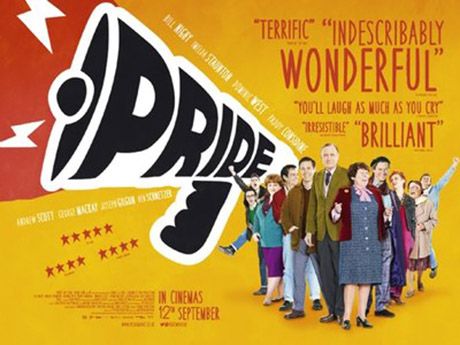Arts
You are here
The meaning of solidarity

October 2, 2014
Pride has been described as a “feelgood” movie and it is definitely that, but so much more. This year is the 30th anniversary of the great miners’ strike in Britain that lasted a year before it went down to defeat by Margaret Thatcher’s hard right government.
It’s a timely movie to be coming out now when so many of us need to be reminded of the power and necessity of solidarity. Pride tells the real life story of LGSM (Lesbians and Gays Support the Miners), a group that was co-founded by two activists in the London gay community, Mark Ashton and Mike Jackson.
Many of the characters in the movie are based on real life counterparts, including Mark Ashton who was a young communist and gay activist who died of an AIDs-related illness in 1987, at the age of 26, just two years after the defeat of the miners’ strike in 1985.
From accounts of other activists at the time Mark was something of “a human firecracker.” You certainly get a sense of this from some of the speeches he makes during the film and the power of his inspiration to gather others to the cause.
Aston argues with those around him that, in spite of what some may think, the LGBT community and the miners have a lot in common. They are both hounded and attacked by the police, the tabloids and some in the general public. He argues that the gay community has been getting a bit of a respite from constant police harassment because the cops are too busy attacking the miners.
LGSM
LGSM starts out modestly with a handful of activists taking up collections at the 1984 Gay Pride march for the striking miners. They try to approach the miners through official union channels in order to donate the money they are collecting, but are met with embarassed silence, avoidance or phone hang-ups.
Frustrated that they are getting nowhere they pick a mining community at random, a small Welsh mining town, and contact the community’s strike support committee directly. It is made up mainly of miners’ wives.
The film follows the development of the relationship between the activists in LGSM and the Welsh mining community. It is not without its bumps; the movie doesn’t try and skirt around the homophobia that exists.
But through determination and unwillingness to give up on both sides a real solidarity is forged. Mark Ashton stands out as one of the acknowledged leaders of the movement but the great thing about Pride is how much it is a film, not about individual heroism, but about how much ordinary people can achieve when they band together.
There are some recognizable actors here, such as Billy Nighy who does a brilliant turn as the secretary for the miners welfare committee, or Imelda Staunton, who is the head of the committee and doesn’t hesitate to confront the bigots in her community. Many will also recognize Dominic West from The Wire, playing one of the first gay men to contract AIDS, who becomes an at first reluctant member of LGSM.
But the cast, true to the spirit of the story of Pride, is really an ensemble where the struggle allows people both to form strong bonds and to exhibit their idiosyncratic and singular personalities.
Music is also woven throughout the movie from Pete Seeger to Billy Bragg. There is a very moving scene at the miner’s hall when one of the miner’s wives begins singing Bread and Roses. Other women join in and eventually the whole hall is on their feet, men and women together.
Change through struggle
One of the main threads of Pride has to do with how struggle can actually change those involved. The women, mostly miners’ wives, find their voices and their strength through the organizing they do. There’s also a moving scene when one of the miners makes a speech in a gay bar to thank the LGBT community for supporting them.
The movie also doesn’t shy away from some of the difficulties of organizing, as when some lesbians decide to form “Lesbians against pit closures.” The 1980s was a period when there was a certain fragmentation of people fighting back, which eventually did a lot to weaken the movement.
However, the overwhelming message of LGSM is the need for people to stick together against Thatcher and the policies that are ruining people’s lives. The miners do eventually go down to defeat and return to work in March 1985.
However, their struggle and the solidarity they received from LGSM does not go unnoticed or without leaving its mark on the people involved. At the Pride March that year droves of Welsh miners come to London with their union banners and lead the march, alongside the activists in LGSM.
This scene had people cheering in the theatre and it goes to show that solidarity doesn’t just go one way. The 1985 Labour Party conference passed a motion to support equal rights for gay men and lesbians. This motion had been previously put forward and defeated. The difference this time was that it passed due to the block votes of the National Union of Mineworkers and its allies.
One of the co-founders of LGSM, Mike Jackson, had this to say when he saw Pride:
“You could glimpse a wonderful revolution, that spark of the dream of people being together. The film gets that so right.” LGSM “changed my life, it is the proudest thing I've done. But I feel the same now, if anything more angry. I hate Margaret Thatcher as much as ever.”
Pride has a lot of lessons and inspiration for activists who want to take on today’s “Margaret Thatchers,” in whatever country we find ourselves.
Section:










